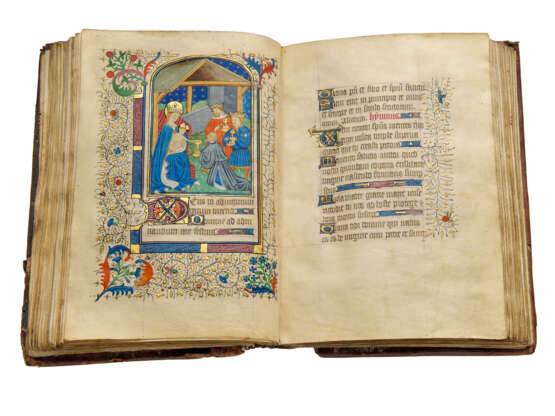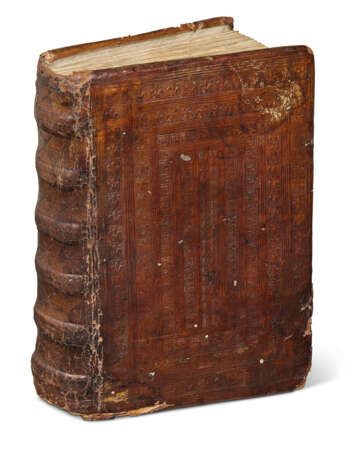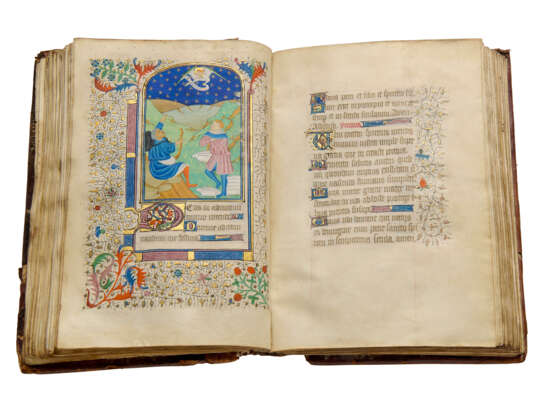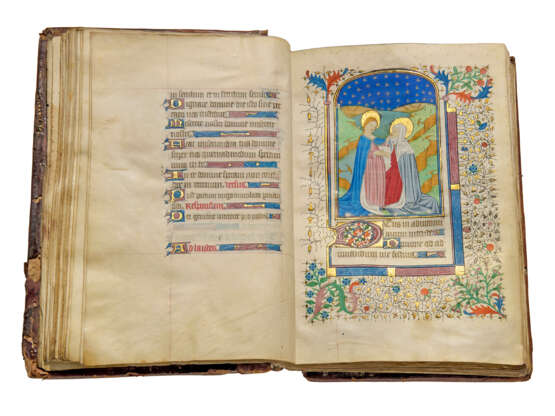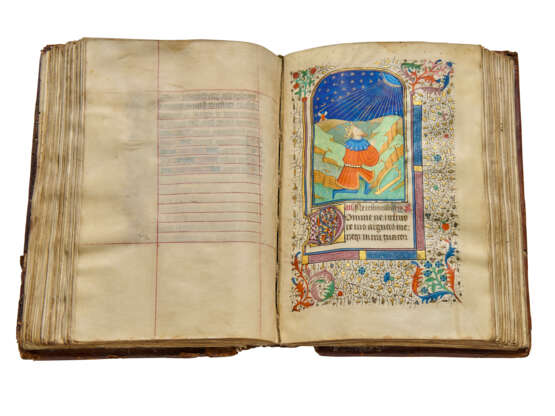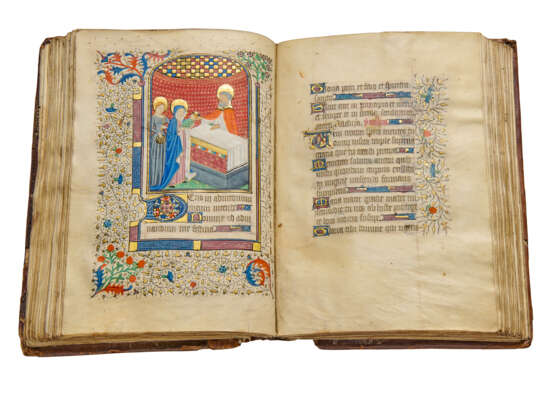ID 1450387
Lot 12 | Talbot Master
Valeur estimée
£ 40 000 – 60 000
Book of Hours, use of Rouen, in Latin and French, illuminated manuscript on vellum [Rouen c.1445-50]
An impressive Book of Hours by the Talbot Master that exemplifies the arresting style of the leading illuminator in Rouen in the decades either side of 1450.
221 x 153mm. 164 leaves, complete, collation: 112, 2-138, 142,15-188,196, 20-218, modern foliation every tenth leaf bottom left, catchwords survive, 16 lines, ruled space: 111 x 71mm, two-line initials with foliate infills on grounds of burnished gold with borders of gold vine leaves and coloured fleurons on hairline tendrils to outer margin only, four similar three-or four-line initials with bar and borders to three sides, thirteen large miniatures above large initials on burnished gold with bars and full borders (some leaves slightly cockled and discoloured, slight smudging to some miniatures and borders, small paint losses including to the face of God the Father, f.41, Virgin’s face rubbed and outlining of her crown lost from halo, f.76v, small offsets to Virgin’s shoulder, f.100, and St John’s neck, f.105v). 15th-century French binding in brown calf tooled in blind with rectangular frames between fillets with, from the outside, tools of a fleur de lys, double headed eagle and stag, surrounding vertical bands of the pelican in its piety either side of two adjacent bands of a seated figure (?woman looking in a mirror) (lacking two fasteners, worn and restored, split to lower joint).
Provenance:
(1) The liturgical use and saints in calendar and litany show that the book was intended for use in or near Rouen: in the sparsely filled calendar in gold are Sts Martial (3 July), Salvator (translation, 6 August) and Romanus, the patron of Rouen, (23 Oct.); among the saints alternately in blue and red are the archbishops of Rouen Sts Ausbert (10 Feb.), Hugh (9 April), Gildard (8 June), Evodius (8 Oct.), Nicasius (11 Oct.). St Audoenus (Ouen) is invoked in the litany, f.97, and there is a memorial to St Romanus, f.48v. The style of the illumination makes Rouen itself the most likely place of production; prayers are in the masculine.
(2) Guillaume Ravend, Sieur de Boisgrimot (c.1655-1733): 'Donné par m. de Boisgrimaut, lieutenant général de Carentan 10 juin 1705 Foucault', f.1. The office of lieutenant général of the bailliage of Carentan in Normandy had become virtually hereditary within the Norman family of Ravend de Boisgrimot and Croucy, ennobled in 1591; in 1705, Guillaume Ravend had been in post from at least 1702 and continued to at least 1713 (E. Lechanteur de Pontaumont, Histoire de la Ville de Carentan et de ses notables, 1863, p.396).
(3) Nicolas Joseph Foucault, marquis de Magny (1643-1721): armorial bookplate inside upper cover: signed autograph note of the gift from Ravend in 1705, f.1. Foucault was based in Normandy from 1689 to1706 as intendant of the generality of Caen, to which Carentan belonged. The dispersal of his famous library, with significant holdings of manuscripts, began during his lifetime.
(4) The manuscript was in English ownership during the 18th century, as shown by the note inside the upper cover: 'See Baudelot, 2 Tome p.431', a reference to C. Baudelot de Dairval, De l’utilité des voyages et de l’avantage que la recherche des antiquités procure aux sçavans, 1689, on the importance and pleasure of preserving manuscripts.
(5) Sotheby’s, 11 September 1932, lot 214, bought by Bertram Rota Ltd.
Content: Calendar, ff.1-12v; Gospel extracts with Passion narrative from St John, ff.13-18v; ruled blanks ff.19-20; Office of the Virgin, use of Rouen, ff.21-84, with memorials after Lauds, opening with the Trinity ff.41-52v; ruled blank f.84v, Penitential Psalms and litany ff.85-99v; Hours of the Cross ff.100-105; Hours of the Holy Spirit ff.105v-109v; ruled blank f.110; Office of the Dead, use of Rouen, ff.111-147v; ruled blank f.148; prayers to the Virgin ff.149-163: Quinze joies f.149, Cinq plaies f.153v, ruled blank f.156v, Obsecro te in masculine f.157, O intemerata in masculine f.160; ruled blank f.164.
Illumination:
The striking miniatures with their strong colours and bold contours are in the style of the Talbot Master, named from manuscripts commissioned by Sir John Talbot, Earl of Shrewsbury (c.1387-1453): the Shrewsbury Book, a compilation of romances and didactic texts presented to Margaret of Anjou when she married Henry VI of England in 1445, and two Books of Hours made for Talbot and his second wife, Margaret Beauchamp, probably a little earlier (BL, Royal ms 15 E VI; Cambridge, Fitzwilliam Museum ms 40-1950; Aberdeen, University, Scottish Catholic Historical Archives, Blairs College ms 1, for these see J. Crispin, Krieg und Kunst, German Historical Institute, London, no 81, 2018, pp.283-310, col. pls 13-20, 26-29). As England’s most feared military commander in the final stages of the Hundred Years War, Talbot was frequently in English ruled Normandy and was in Rouen when it surrendered to Charles VII of France in 1449. From the liturgical use of the present lot and other books illuminated by the Talbot Master, Rouen was where he worked. He remained there after 1449 illuminating books for the town council, notably BnF ms fr. 126 with its anti-English texts, as well as for individual patrons and the open market (see F. Avril and N. Reynaud, Les manuscrits à peintures en France 1440-1520, 1993, no 88, pp.169-171).
This large Book of Hours was perhaps a special commission, which, with its untrimmed margins, still presents the Talbot Master’s style to great advantage. He owes much to the Fastolf Master, also named for an English patron, who took refuge from troubled Paris in the comparative stability of Rouen and then, unlike the Talbot Master, retreated over the Channel with the English. Both prioritised surface pattern over spatial illusion: in the Talbot Master’s work, contours are crisply defined around comparatively flat areas of fresh, bright colour and backgrounds are literally patterned, with gold diapering, gold stars on rich blue skies, or on red behind the Crucifixion, and gold motifs on cloth hangings. Facial features are delineated with characteristically broad eyes, two lines to define noses and touches of red to shape rosebud lips.
Several hands working in this style are evident in the manuscripts made for Sir John Talbot, blurring the precise identity of the Talbot Master. In this Rouen Hours, the smaller headed figures in the Flight into Egypt may be the work of the illuminator who contributed some miniatures to the Shrewsbury Book, for instance for the Quatre fils d’Aymon, and possibly the miniature of Talbot and his Countess kneeling to the Virgin in the Blairs College Hours. Of the more accomplished miniatures, some follow the same patterns as those used in the Fitzwilliam Hours, although adapted to the more spacious, taller miniature format, e.g. the Office of the Dead and, with some variation, the Adoration of the Magi (images available on the Fitzwilliam Museum website). Execution as well as compositions are comparable: the principal illuminator of the Fitzwilliam Talbot Hours, and of the Shrewsbury Book, seems largely responsible for the present lot.
The subjects of the miniatures are: the Annunciation f.21, Visitation f.31, the Trinity f.41, Nativity f.53, Annunciation to the Shepherds f.58v, Adoration of the Magi f.62v, Presentation in the Temple f.66v, Flight into Egypt f.70v, Coronation of the Virgin f.76v, David in penitence f.85, Crucifixion f.100, Pentecost f.105v, two clerics and a group of mourners by a coffin f.111.
| Lieu d'origine: | Europe de l'Ouest, France, Europe |
|---|---|
| Catégorie maison de vente aux enchères: | Manuscrits médiévaux et de la Renaissance, Livres et manuscrits |
| Lieu d'origine: | Europe de l'Ouest, France, Europe |
|---|---|
| Catégorie maison de vente aux enchères: | Manuscrits médiévaux et de la Renaissance, Livres et manuscrits |
| Adresse de l'enchère |
CHRISTIE'S 8 King Street, St. James's SW1Y 6QT London Royaume-Uni | |
|---|---|---|
| Aperçu |
| |
| Téléphone | +44 (0)20 7839 9060 | |
| Commission | see on Website | |
| Conditions d'utilisation | Conditions d'utilisation |
